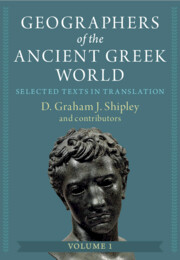Book contents
- Frontmatter
- Dedication
- Epigraph
- Contents
- List of Figures
- List of Maps
- List of Tables
- Contributors
- Preface
- Glossary
- Abbreviations
- Introduction: Greek Geography and Geographers
- Time-line
- Prologue: The Homeric Catalogue of Ships (Iliad, 2. 484–760)
- Part I Archaic Period
- Part II Classical Period
- Part III Hellenistic Period
- 9 Dikaiarchos of Messana
- 10 Timosthenes of Rhodes
- 11 Herakleides Kritikos
- 12 Eratosthenes of Kyrene
- 13 Mnaseas of Patara
- 14 Skymnos of Chios
- 15 Agatharchides of Knidos, On the Erythraian Sea
- 16 Hipparchos of Nikaia
- 17 The Nikomedean Periodos [‘Pseudo-Skymnos’]
- 18 Artemidoros of Ephesos
- 19 Poseidonios of Apameia
- 20 Dionysios son of Kalliphon
20 - Dionysios son of Kalliphon
from Part III - Hellenistic Period
Published online by Cambridge University Press: 25 March 2024
- Frontmatter
- Dedication
- Epigraph
- Contents
- List of Figures
- List of Maps
- List of Tables
- Contributors
- Preface
- Glossary
- Abbreviations
- Introduction: Greek Geography and Geographers
- Time-line
- Prologue: The Homeric Catalogue of Ships (Iliad, 2. 484–760)
- Part I Archaic Period
- Part II Classical Period
- Part III Hellenistic Period
- 9 Dikaiarchos of Messana
- 10 Timosthenes of Rhodes
- 11 Herakleides Kritikos
- 12 Eratosthenes of Kyrene
- 13 Mnaseas of Patara
- 14 Skymnos of Chios
- 15 Agatharchides of Knidos, On the Erythraian Sea
- 16 Hipparchos of Nikaia
- 17 The Nikomedean Periodos [‘Pseudo-Skymnos’]
- 18 Artemidoros of Ephesos
- 19 Poseidonios of Apameia
- 20 Dionysios son of Kalliphon
Summary
This chapter presents a new annotated translation (in loose English iambic pentameters) of the two surviving passages of a didactic poem by one Dionysios son of Kalliphon (early to mid-1st century BC), describing mainland Greece and the Aegean in coastal sequence. The chapter introduction evaluates the evidence for the poem’s date, the Stoic influences upon it, and its debts to Artemidoros and Apollodoros; and offers new prosopographical evidence suggesting that the poet was born into intellectual circles at Athens. The work–perhaps a private tribute to an Old Greece that was being overwhelmed by Roman power–left no discernible legacy and has excited surprisingly little scholarly interest. The translation replicates the acrostic that identifies the author’s name.
Keywords
- Type
- Chapter
- Information
- Geographers of the Ancient Greek WorldSelected Texts in Translation, pp. 612 - 619Publisher: Cambridge University PressPrint publication year: 2024

